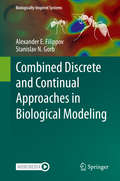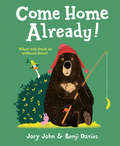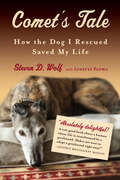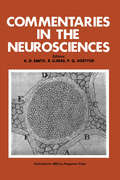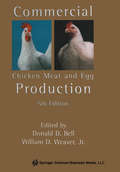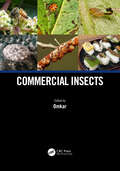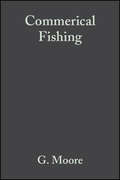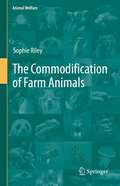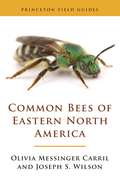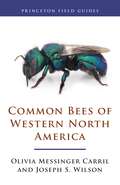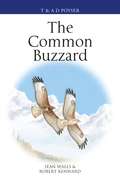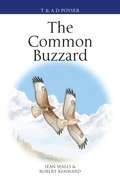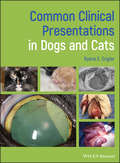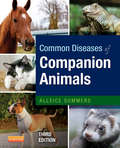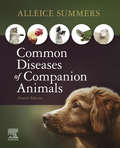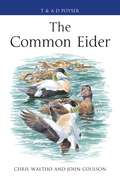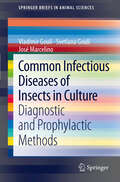- Table View
- List View
Colton's Christmas Cop: Colton's Christmas Cop Rancher's High-stakes Rescue Killer Smile Undercover Passion (The Coltons of Red Ridge #11)
by Karen WhiddonA rookie cop's mistletoe mission
Colton's Deadly Engagement: Colton's Deadly Engagement Guardian Cowboy Her Mission With A Seal Undercover Protector (The Coltons of Red Ridge #2)
by Addison FoxTo catch a killer… They’ll fake an engagement…
Colton's Twin Secrets: Colton's Twin Secrets Conard County Watch Ranger's Justice Rocky Mountain Valor (The Coltons of Red Ridge #9)
by Justine DavisA cop and Colton nanny come under fire
Combined Discrete and Continual Approaches in Biological Modelling (Biologically-Inspired Systems #16)
by Alexander E. Filippov Stanislav N. GorbBasic laws of nature are rather simple, but observed biological structures and their dynamic behaviors are unbelievably complicated. This book is devoted to a study of this “strange” relationship by applying mathematical modeling to various structures and phenomena in biology, such as surface patterns, bioadhesion, locomotion, predator-prey behavior, seed dispersal, etc. and revealing a kind of self-organization in these phenomena. In spite of diversity of biological systems considered, two main questions are (1) what does self-organization in biology mean mathematically and (2) how one can apply this knowledge to generate new knowledge about behavior of particular biological system? We believe that this kind of “biomimetics” in computer will lead to better understanding of biological phenomena and possibly towards development of technical implications based on our modeling.
Come Home Already!
by Jory JohnDuck and Bear are BACK – but where has Bear gone? And what will Duck do without him?
Comet and the Champion’s Cup (Pony Club Secrets #5)
by Stacy GreggThe fifth gripping adventure in this exciting new pony-club series. With gymkhanas to win, rivals to defeat, mysteries to solve and ponies in danger to save – these books are perfect for all girls who love ponies.
Comet's Tale: How the Dog I Rescued Saved My Life
by Steven Wolf Lynette PadwaComet’s Tale is a story about a friendship between two former winners, both a little down on their luck, who together stage a remarkable comeback. A former hard-driving attorney, Steven Wolf has reluctantly left his job and family and moved to Arizona for its warm winter climate. There he is drawn to a local group that rescues abused racing greyhounds. Although he can barely take care of himself because of a spinal condition, Wolf adopts Comet, an elegant cinnamon-striped racer. Or does Comet adopt Wolf? In Comet’s Tale we follow their funny and moving journey as Wolf teaches Comet to be a service dog. With her boundless enthusiasm and regal manners, Comet attracts new friends to Wolf’s isolated world. And finally, she plays a crucial role in restoring his health, saving his marriage, and broadening his definition of success.
Commentaries in the Neurosciences
by A.D. SMITH, R. LLINÁS, P.G. KOSTYUKCommentaries in the Neurosciences is a compilation of the commentaries segment featured in the Neuroscience journal. This book, however, does not provide a comprehensive account of all fields in neuroscience, but rather articles that highlight developments during the past years. The topics covered include chemistry and dynamics of neurotransmitter storage particles; release of central and peripheral neurotransmitters; and transmitters in the enteric nervous system. This book also discusses the properties of neuroreceptors; chemistry and connections of the cerebral cortex; and intracellular recording and ionic transmembrane currents. This text explains as well the invertebrate nervous systems; functions of the nervous system including neuro- and psychopharmacology; and the mind-body problem. This book will be of use not only to research workers interested in keeping updated with developments in different areas of the neurosciences, but also to advanced undergraduate and graduate students who are studying the nervous system.
Commercial Chicken Meat and Egg Production
by Donald D. BellCommercial Chicken Meat and Egg Production is the 5th edition of a highly successful book first authored by Dr. Mack O. North in 1972, updated in 1978 and 1984. The 4th edition was co-authored with Donald D. Bell in 1990. The book has achieved international success as a reference for students and commercial poultry and egg producers in every major poultry producing country in the world. The 5th edition is essential reading for students preparing to enter the poultry industry, for owners and managers of existing poultry companies and for scientists who need a major source of scientifically based material on poultry management. In earlier editions, the authors emphasized the chicken and its management. The 5th edition, with the emphasis shifted to the commercial business of managing poultry, contains over 75% new material. The contributions of 14 new authors make this new edition the most comprehensive such book available. Since extensive references are made to the international aspects of poultry management, all data are presented in both the Imperial and Metric form. Over 300 tables and 250 photos and figures support 62 chapters of text. New areas include processing of poultry and eggs with thorough discussions of food safety and further processing. The business of maintaining poultry is discussed in chapters on economics, model production firms, the use of computers, and record keeping. Updated topics include: breeders and hatchery operations; broiler and layer flock management; replacement programs and management of replacements; nutrition; and flock health. New chapters address flock behavior, ventilation, waste management, egg quality and egg breakage. Other new features include a list of more than 400 references and a Master List of the tables, figures, manufacturers of equipment and supplies, research institutions, books and periodicals, breeders, and trade associations. Commercial growers will find the tables of data of particular interest; scientists will be able to utilize the extensive references and to relate their areas of interest to the commercial industry's applications; and students will find that the division of the book into 11 distinct sections, with multiple chapters in each, will make the text especially useful.
Commercial Insects
by OmkarDespite being the biggest group of organisms inhabiting Earth in both diversity and sheer numbers, insects are barely commercialized. Most of the standard textbooks of applied entomology talk about insect pest management, and when it comes to commercial aspects of insects, only apiculture, sericulture, and lac culture are talked about. This book will help bring other commercial uses of insects and their economic potential to the fore. This will generate interest in further research on the commercial potential of insects, thereby harnessing a much-found resource. The book has the following salient features: 1. Encompasses all major aspects of beneficial and commercial insects. 2. Deals with edible insects and mass culture of natural enemies and beneficial insects. 3. Emphasis on the mass cultivation of beneficial insects for obtaining yields. 4. Discusses stingless bees and their products. 5. Helps to solve the problem of food scarcity and improve food security.
Commercial Insects
Despite being the biggest group of organisms inhabiting Earth in both diversity and sheer numbers, insects are barely commercialized. Most of the standard textbooks of applied entomology talk about insect pest management, and when it comes to commercial aspects of insects, only apiculture, sericulture, and lac culture are talked about. This book will help bring other commercial uses of insects and their economic potential to the fore. This will generate interest in further research on the commercial potential of insects, thereby harnessing a much-found resource. The book has the following salient features: 1. Encompasses all major aspects of beneficial and commercial insects. 2. Deals with edible insects and mass culture of natural enemies and beneficial insects. 3. Emphasis on the mass cultivation of beneficial insects for obtaining yields. 4. Discusses stingless bees and their products. 5. Helps to solve the problem of food scarcity and improve food security.
Commerical Fishing: The Wider Ecological Impacts
by G. Moore Simon JenningsFishing provides food, income and employment for millions of people. However, fishing has environmental costs that threaten rare species, marine ecosystems and the sustainability of the resource. Based on the research expertise of leading scientists, Commercial Fishing: the Wider Ecological Impacts provides a lively, timely and accessible account of fishing activities and their impacts on marine habitats, biodiversity and species of conservation concern. It covers fishing methods that range from trawling in the Antarctic to fishing with dynamite in the tropics. The authors show how habitats such as the muddy sea beds of the deep sea, kelp forests and coral reefs are affected by fishing and how birds, mammals, turtles and sea snakes both suffer and benefit from fishing activities. They also look to the future, highlighting ways to make fishing gear 'environmentally friendly' and asking whether marine reserves will improve conservation.
The Commodification of Farm Animals (Animal Welfare #21)
by Sophie RileyThis book examines how the developments in veterinary science, philosophy, economics and law converged during the nineteenth and early twentieth centuries to entrench farm animals along a commodification pathway. It covers two neglected areas of study; the importance of international veterinary conferences to domestic regimes and the influence of early global treaties that dealt with animal health on domestic quarantine measures. The author concludes by arguing that society needs to reconsider its understanding and the place of the welfare paradigm in animal production systems. As it presently stands, this paradigm can be used to justify almost any self-serving reason to abrogate ethical principles.The topic of this book will appeal to a wide readership; not only scholars, students and educators but also people involved in animal production, interested parties and experts in the animal welfare and animal rights sector, as well as policy-makers and regulators, who will find this work informative and thought-provoking.
Common Bees of Eastern North America (Princeton Field Guides #151)
by Olivia Messinger Carril Joseph S. WilsonThe only portable full-color photographic guide to the most commonly seen bees east of the Mississippi RiverBees play a vitally important role in the pollination of native plants and agricultural crops around the globe. Common Bees of Eastern North America is the first species-level photographic field guide to the most commonly seen bees in the eastern United States and Canada. Identifying bees to species is challenging even for taxonomists. This book walks you through the process of bee identification using breathtaking high-resolution color photos that highlight the unique characteristics of each species, making identification easier. Full of essential facts about the natural history of these magnificent creatures, this is the must-have field guide for naturalists and backyard gardeners alike.Covers 125 of the most commonly seen species in the eastern United States and CanadaFeatures 500 stunning close-up photos in full colorShows multiple images for each species, with arrows highlighting key identifying marksProvides silhouette images depicting the actual size of each speciesDescribes key identification features, size, phenology, floral preference, nesting, and related speciesIncludes a range map for every speciesContains a taxonomic key to the bee genera of the eastern United States and Canada
Common Bees of Western North America (Princeton Field Guides #124)
by Olivia Messinger Carril Joseph S. WilsonA portable, full-color photographic guide to the most commonly seen bees in the western United States and CanadaBees play a vitally important role in the pollination of native plants and agricultural crops around the globe. These stunningly beautiful insects come in a wide range of sizes, shapes, and colors. There are more than 3,000 species in western North America, and identifying them is a challenging task even for taxonomists. Common Bees of Western North America is the first species-level photographic field guide to the most commonly seen bees in the western United States and Canada, focusing on those that are found in urban environments, specialize on unique plants, or are especially distinctive in appearance. This book walks you through the process of bee identification using breathtaking high-resolution color photos that highlight the key characteristics of each species, making identification easier. Full of essential facts about the natural history of these magnificent creatures, this is a must-have field guide for naturalists and backyard gardeners alike.Covers more than 200 speciesFeatures more than 1,100 stunning close-up color photosShows multiple images of each species, with arrows indicating key featuresIncludes a range map for every speciesProvides silhouette images depicting the actual size of each speciesDescribes key identification features, size, phenology, floral preference, nesting, and related speciesContains a taxonomic key to the bee genera of the region
The Common Buzzard (Poyser Monographs)
by Sean Walls Robert Kenward'Based on many years of personal research, and a thorough knowledge of the European literature, the authors provide an eminently readable account of the biology of the Common Buzzard. Whatever your interests in birds, I can recommend this book for its content of information and insight.'Professor Ian Newton OBE, FRS, FRSESoaring majestically on thermals with broad wings raised, the Common Buzzard is a familiar sight for many people across Eurasia. In fact, thanks to a remarkable ability to adapt to local conditions, it is now one of the most abundant hawks in the world. The Common Buzzard can exploit a variety of nest sites, and has an eclectic diet that ranges from earthworms and voles to woodpigeons and even deer carcasses. This is a species rich in paradoxes. Why does a hawk evolved for hunting small mammals thrive on invertebrates and carrion? How can a raptor renowned for dramatic territorial displays occur at such high densities? And why does such a large bird that can travel long distances spend so much time in small areas? Sean Walls and Robert Kenward delve deep into the ecology of the Common Buzzard to provide answers to these questions and many more, as well as examining the conservation conundrums raised by this bird. Bringing together a wealth of research on the species' origins, feeding behaviour and breeding, along with information on movement and survival from the authors' own studies, The Common Buzzard provides an invaluable insight into exactly what has enabled this marvellous raptor to return to old haunts to impress, inspire and connect people with nature.
The Common Buzzard (Poyser Monographs)
by Sean Walls Robert Kenward'Based on many years of personal research, and a thorough knowledge of the European literature, the authors provide an eminently readable account of the biology of the Common Buzzard. Whatever your interests in birds, I can recommend this book for its content of information and insight.'Professor Ian Newton OBE, FRS, FRSESoaring majestically on thermals with broad wings raised, the Common Buzzard is a familiar sight for many people across Eurasia. In fact, thanks to a remarkable ability to adapt to local conditions, it is now one of the most abundant hawks in the world. The Common Buzzard can exploit a variety of nest sites, and has an eclectic diet that ranges from earthworms and voles to woodpigeons and even deer carcasses. This is a species rich in paradoxes. Why does a hawk evolved for hunting small mammals thrive on invertebrates and carrion? How can a raptor renowned for dramatic territorial displays occur at such high densities? And why does such a large bird that can travel long distances spend so much time in small areas? Sean Walls and Robert Kenward delve deep into the ecology of the Common Buzzard to provide answers to these questions and many more, as well as examining the conservation conundrums raised by this bird. Bringing together a wealth of research on the species' origins, feeding behaviour and breeding, along with information on movement and survival from the authors' own studies, The Common Buzzard provides an invaluable insight into exactly what has enabled this marvellous raptor to return to old haunts to impress, inspire and connect people with nature.
Common Clinical Presentations in Dogs and Cats
by Ryane E. EnglarCommon Clinical Presentations in Dogs and Cats is a reliable resource and quick reference to essential information for diagnosing canine and feline patients, based on presenting complaints. The text takes a problem-oriented approach to recognizing common clinical conditions, and introduces diagnostic and treatment plans for companion animal practice. Equally useful for veterinary students and practicing clinicians, the book presents 78 chapters grouped by body system, for ease of access. Each chapter focuses on identifying the chief complaint, pinpointing possible diagnoses, and determining the clinical approach to patient care. The book is richly illustrated throughout with clinical photographs and line drawings that demonstrate the concepts presented. Common Clinical Presentations in Dogs and Cats is an essential resource that: • Gives clinicians fast access to essential details for approaching common case presentations in dogs and cats and forming a correct diagnosis• Presents information by clinical signs, organized by body system• Takes a standardized chapter format for ease of use• Includes color photographs and line drawings to illustrate the conditions discussed Written for small animal general practitioners and veterinary students, Common Clinical Presentations in Dogs and Cats is a patient-side reference that can help practitioners gain the knowledge and confidence to correctly diagnose a wide range of clinical presentations.
Common Clinical Presentations in Dogs and Cats
by Ryane E. EnglarCommon Clinical Presentations in Dogs and Cats is a reliable resource and quick reference to essential information for diagnosing canine and feline patients, based on presenting complaints. The text takes a problem-oriented approach to recognizing common clinical conditions, and introduces diagnostic and treatment plans for companion animal practice. Equally useful for veterinary students and practicing clinicians, the book presents 78 chapters grouped by body system, for ease of access. Each chapter focuses on identifying the chief complaint, pinpointing possible diagnoses, and determining the clinical approach to patient care. The book is richly illustrated throughout with clinical photographs and line drawings that demonstrate the concepts presented. Common Clinical Presentations in Dogs and Cats is an essential resource that: • Gives clinicians fast access to essential details for approaching common case presentations in dogs and cats and forming a correct diagnosis• Presents information by clinical signs, organized by body system• Takes a standardized chapter format for ease of use• Includes color photographs and line drawings to illustrate the conditions discussed Written for small animal general practitioners and veterinary students, Common Clinical Presentations in Dogs and Cats is a patient-side reference that can help practitioners gain the knowledge and confidence to correctly diagnose a wide range of clinical presentations.
Common Diseases of Companion Animals - E-Book
by Alleice SummersGain quick access to the most common diseases that veterinary technicians encounter with Common Diseases of Companion Animals, 3rd Edition. This reference is divided into sections by species, with chapters in each section organized by body system. Each disease is presented in monograph form, with clinical signs, diagnostic laboratory work-up, treatment options, and client information to ensure the information you need is always at hand. Well-organized content presents diseases in a consistent, monograph style, including description, clinical signs, laboratory work-up, treatment, medications, after care, client information, and prevention.Diseases organized by body system enables you to quickly refer to the most accurate information.Coverage of the common diseases veterinary technicians are likely to encounter in practice keeps you up-to-date with the diseases and disorders you are most likely to assist in diagnosing and managing.Clearly defined role of the technician helps you understand what is expected of you as a working professional.Tech Alerts emphasize key information on the process of caring for pets.NEW! Introductory chapter on pathophysiology provides information on the foundations of disease and the body’s response to disease before proceeding to the specific diseases of each system.NEW! Expanded nursing care sections include descriptions of changes in clinical signs with improvement or decline that will affect treatment, as well as more Tech Alerts to highlight the veterinary technician’s responsibilities.NEW! An increase in the number and variety of review questions, including open-ended critical thinking questions.NEW! Full-color design and illustration program reinforces what diseases look like — such as signs exhibited in the animal, in lab specimens, and in surgical corrections — and demonstrates techniques, such as urethral catheter placement in a female cat. NEW! Vet Tech Threads direct learning by outlining key terms, learning objectives, and the glossary.NEW! Pageburst eBook interactive features offer a dynamic learning environment.
Common Diseases of Companion Animals E-Book
by Alleice SummersSolidify your understanding of the most common diseases you’ll encounter as a veterinary technician! Common Diseases of Companion Animals, 4th Edition is an easy-to-use reference that’s divided into sections by species, with chapters in each section organized by body system. Each disease is presented in monograph form, with clinical signs, diagnostic laboratory work-up, treatment options, and client information to ensure the information you need is always available. New to this edition is coverage of backyard chickens and potbellied pigs This succinct text provides invaluable coverage for veterinary technology students and also serves as a handy reference for working practitioners.Coverage of the common diseases veterinary technicians are likely to encounter in practice keeps students up-to-date with the diseases and disorders they are most likely to assist in diagnosing and managing.Diseases organized by body system enables students to quickly refer to the most accurate information.Consistent, monograph format includes a description, clinical signs, laboratory work-up, treatment, medications, after care, client information, and prevention for each disease.Clearly defined role of technician helps students understand what is expected of them as a working professional.Tech Alerts emphasize key information on the process of caring for pets.Introductory chapter on pathophysiology provides information on the foundations of disease and the body’s response to disease before proceeding to the specific diseases of each system.Full-color design and illustration program reinforces what diseases look like — such as signs exhibited in the animal, in lab specimens, and in surgical corrections — and demonstrates techniques, such as urethral catheter placement in a female cat. Nursing care sections include descriptions of changes in clinical signs with improvement or decline that will affect treatment, as well as more Tech Alerts to highlight the veterinary technician’s responsibilities.A variety of review questions, including open-ended critical thinking questions.Vet Tech Threads direct learning by outlining key terms, learning objectives, and the glossary.NEW! Chapters on backyard chickens and potbellied pigs.NEW! EXPANDED content includes the latest information on disease prevention.NEW! Coverage of new veterinary diseases ensures that you have the most up-to-date information available.
The Common Eider
by Chris Waltho John CoulsonA common sight around the more northerly shores of the British Isles, the Common Eider is the largest duck in the northern hemisphere. The eider is particularly well adapted to cold-water environments; the insulating properties of eider down are iconic. The species is taxonomically interesting, with a range of well-marked subspecies reflecting the patterns of ice coverage during ancient glaciations, and these ducks have also provided the focus for a number of important behavioural studies, especially on feeding ecology and energy budgets.Eiders have a long association with humans, and have deep cultural significance in many societies. However, modern lifestyles are exposing these ducks to a wide range of new pressures.This monograph provides a comprehensive portrait of the Common Eider; authors Chris Waltho and John Coulson bring together an extensive and diverse international literature, with sections on taxonomy, habitats, breeding biology, population dynamics, diet and foraging, dispersal and migration, and conservation.
The Common Eider (Poyser Monographs #35)
by Chris Waltho John CoulsonA common sight around the more northerly shores of the British Isles, the Common Eider is the largest duck in the northern hemisphere. The eider is particularly well adapted to cold-water environments; the insulating properties of eider down are iconic. The species is taxonomically interesting, with a range of well-marked subspecies reflecting the patterns of ice coverage during ancient glaciations, and these ducks have also provided the focus for a number of important behavioural studies, especially on feeding ecology and energy budgets.Eiders have a long association with humans, and have deep cultural significance in many societies. However, modern lifestyles are exposing these ducks to a wide range of new pressures.This monograph provides a comprehensive portrait of the Common Eider; authors Chris Waltho and John Coulson bring together an extensive and diverse international literature, with sections on taxonomy, habitats, breeding biology, population dynamics, diet and foraging, dispersal and migration, and conservation.
Common Infectious Diseases of Insects in Culture: Diagnostic and Prophylactic Methods (SpringerBriefs in Animal Sciences)
by Vladimir Gouli Svetlana Gouli Jose MarcelinoThis handbook gives a comprehensive and copious illustrated description, with original art work, of the most common diseases in laboratory reared insect colonies, comprising Viruses (Baculoviridae, Reoviridae, Poxviridae, Iridoviridae); Bacteria (Bacillaceae, Pseudomonadaceae, Enterobacteriaceae); Rickettsia; Fungi and Microsporidia and Protozoa. Gregarine and Coccidian parasitoids are also depicted. Manuals for the diagnostic of insect diseases have been published in the 90’s, however, these were intended for professional insect pathologists or for proficient training in invertebrate pathology, hence requiring some scientific background in insect pathology. Currently, most guides are web based, not comprehensive and solely addressing the most common diseases in a particular insect, or group of insects, reared in laboratory facilities. A comprehensive and proficient practical handbook for students and technicians working with insect reared colonies is lacking in the current literature.
Common Toad (Large Print)
This is a picture of a Common Toad viewed from the side and facing to the left. There is a locator dot shown, which will be at the top left of the page when the image is the right way up. On the far left is the toad's head with its open mouth and one eye visible. The toad's body is to the right. Two of the toad's legs, with three toes on each, can be found down from its body towards the bottom of the page. The other two legs are hidden behind the body. The body and legs of the toad are covered with warty lumps.



